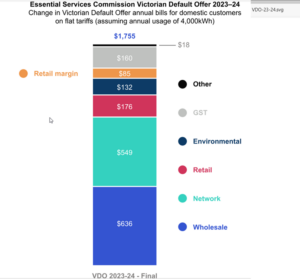Electricity prices, the energy market, and the type of generation in the mix used to be irrelevant topics for the average Australian household. We click the switch and the lights come on.
A few years ago, that started to change, the topic of green energy, the carbon tax, the “National Energy Guarantee”, and the like became the stuff that would bring down a prime minister.
Now the topic of energy seems to be more prominent in the media than ever before. There are so many voices with opposing agendas. A good example of this is the recent debate about nuclear power stations.
Retailers’ role in the supply chain
There are countless independent generation assets that make energy, and they want to sell that energy for the best price they can get, but they also compete with each other.
The Australian Energy Market Operator (AEMO) coordinates all the various buyers and sellers by providing a marketplace where all this energy can be sold to meet demand.
The distribution networks charge to recover the cost of building and maintaining the infrastructure that distributes energy. On top of that are renewable energy certificates and associated costs. The retailer is tasked with billing the customer.
The changing cost of electricity
As a retailer, we have been following the wholesale market very closely. We also monitor the distribution costs, renewable certificate costs, and the general market trend.
We’ve been writing about the cost of electricity since early 2017 and, unfortunately, the trend has not been in the favour of consumers. Hopefully, we’ve been able to explain some factors and issues and help people understand how the industry operates.
Of course, we’ve also written quite a lot about the development and increasing influence of energy from renewable sources and the transition away from traditional energy sources, including how challenging that has proven to be.
While we can’t do much to assist the transition or reduce the cost of energy, we hope that providing you with useful information is playing a small part in helping you understand what’s happening, what we anticipate happening in the future, and what you might be able to do about your own energy consumption and bills.
We understand that consumer confidence is low
A recent survey, conducted by Energy Consumers Australia, found that consumer confidence in the energy market is the lowest since 2018.
The survey results showed only half of all Australian households (54 per cent) believed their electricity service provided value for money. That’s down from 59 per cent a year ago and 67 per cent in 2021.
This reduced level of confidence was attributed to soaring energy bills as well as a lack of belief that technological advances will help better manage energy supply and costs.
The drop was particularly noticeable in Victoria, where the ‘satisfied’ figure was down by seven percentage points, and NSW, where it was six percentage points lower than last year.
It’s a particularly precarious time
As we discussed in our last blog post, the whole world is currently grappling with how to speed up the transition from fossil fuels to renewable sources, with the goal of reducing emissions and reaching net zero.
The Australian government has repeatedly reiterated its commitment to those objectives, however, to be very blunt, has failed to convincingly explain how that will be achieved.
If there are people involved in the energy market and who will have the biggest say in how the transition is managed who don’t have full confidence, how can we possibly expect the average consumer to believe that we can increase renewable energy capacity and also reduce the cost of energy?
“Consumers do not have trust in the market, yet we need them to be engaged for the energy transition to be successful,” Energy Consumers Australia chief executive Dr Brendan French warned.
“Consumers need support and good information on energy to give them the confidence to engage with the energy market – and that need will only increase as we make the transition to net zero.”
Dr French believes that consumers need help to understand how to reduce energy use and cost, particularly as more people have reported struggling with rising bills.
“If we don’t provide that help, the energy divide will increase and things will continue to get worse for an increasing number of households,” he said.
“This should be a wake-up call for the entire industry.”
We agree that more transparency is a good thing. We also believe that consumers have a right to know where the cost of energy comes from. One of the best places to get a glimpse into what makes up a typical energy bill is a “costs stack” chart. The one below (taken from page 4 of the Victorian Default Offer 2023–24 Final Decision Paper) shows the components that make up a typical household bill on a default energy plan. The retail margin is the thin orange slice.
Although this may not be directly relevant to your specific energy plan, it provides a good overall insight into a typical energy bill.
Knowledge is power. The more you understand the drivers, the less likely political spin and media clickbait can throw you off the scent.
As a company that listens to our customers, we will keep advocating for consumers and doing all we can to ensure customer feedback gets to the powers that be.

